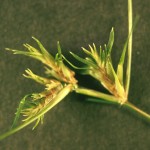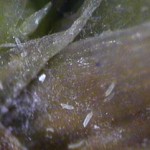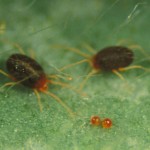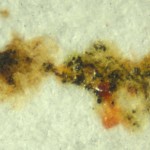Bermudagrass Mites
The Bermudagrass (stunt) mite is a host specific mite. Its characteristic damage is shortened internodes that produce a typical rosetting and tufted growth, or a “witch broom” effect. When left uncontrolled, large areas of turf are killed. This has become a problem on some lawns in north and central Texas. A similar mite causes almost identical damage to buffalograss (Buffalo grass).
Mechanical Control
For Bermudagrass stunt mites (eriophyid mite), where there are no available insecticidal/miticidal control products, cultural practices as follows: an infrequent scalping to remove ca 98% of the infestation; remove clippings from the area (they are full of mites) and destroy off-site; grow the grass ahead of the mites with adequate H2O and fertilization (personal communication Dr. Jim Reinert, 2011).
Clover Mites
Occasionally, some pests that occur on plants around the home will move indoors. The clover mite, Bryobia praetiosa Koch (Acari: Tetranychidae), and several related plant-feeding species can become a nuisance when they migrate in large numbers into homes and other buildings. Clover mites do not bite, transmit disease or feed indoors, but their invasive habits and excessive numbers can be very annoying.
This pest species feeds on over 200 species of plants including many grasses and herbaceous plants. It has been reported feeding and developing on the leaves of clover, bluebonnets, beans, tomatoes, strawberries, sweet peas, violets, shepherd’s purse and other broadleaf and grassy weeds, and some grasses. The mites reach high populations in early spring and occasionally in the fall. When numerous, they commonly leave their host plants and wonder over sidewalks, foundation walls and occasionally indoor areas which they enter via cracks, crevices, and other openings. Clover mites can become numerous indoors especially during the cooler periods of the year.
Description
Clover mites are related to two-spotted spider mites but are slightly larger (less than 0.04 inch or 1 mm in length). The body color varies but can be brick red or greenish. Adult mites have four pairs of legs, but the front pair of legs is about twice as long as the other legs and extends in front of the body. The reddish color and extended front legs are the identifying characteristics of this pest. Eggs are round, red in color, and found in the areas of highest mite activity. Eggs are laid on walls of buildings, in cracks in concrete, on the bark at the base of trees or on other protected sites. A 10 X hand lens provides adequate magnification to see either mites or eggs. When crushed, the mites and their eggs produce a reddish smear that can blemish walls and other surfaces.
Damage
Turfgrasses attacked by clover mites may show a loss of green chlorophyll in the leaves, and grass blades may exhibit silvery streaks or specks. Damage resembles the pale spots or “stippling” on leaves caused by spider mites. Unlike spider mite, however, clover mites do not produce the silken threads. Damage typically peaks in early spring (March or April) and usually ends by mid-May as temperatures rise. A secondary peak of activity may occur in the fall. When infestations are heavy, infested grass may fail to green up normally. Clover mite damage usually shows up first on the sunny southern and western sides of the house or other structure. Clover mites are normally only a nuisance. However, in lush or well-fertilized lawns clover mites can occasionally cause a lot of damage. Although clover mites have been reported to be a minor turfgrass pest in the United States, particularly to turf near structures, they are normally only a problem in the more northern regions of Texas.
Life Cycle and Habits
The clover mite occurs throughout the United States and southern Canada. Although clover mites have been reported to be a minor turfgrass pest in the United States, around structures they are common only in northern Texas counties. Clover mites prefer cooler temperatures and are active primarily in the spring and fall. In Texas and other southern states, both active adults and eggs may overwinter, resulting in two or three overlapping generations during the spring. Eggs that over-winter hatch as soon as early February, and one or more generations can be completed in the spring. The life cycle occurs over about 30 days. Eggs that are laid in the spring may remain dormant throughout the summer and hatch upon the arrival of cooler temperatures in the fall. Feeding and egg-laying can continue until the first hard freeze and the turfgrass dormancy. On warmer days, clover mites may aggregate on walls and move into buildings through cracks, windows or doors. Drought, other turf stress or overpopulation may also trigger mite invasions of structures.
Management
When reddish mites are detected that leave a red-green smear when crushed are found indoors, clover mites should be suspected. Indoors, clover mites should be removed with a vacuum cleaner to avoid staining.
When mites become a problem outdoors, examine plants around the structure – particularly grasses, clovers and other weeds. Look for discolored leaves with mites on the underside of leaves. When feasible, mow, remove, trim, or otherwise eliminate host plants from at least a 3-feet wide area around the structure to reduce mite habitat. High valued ornamental plants or turf should be kept vigorous through proper watering and fertilizing. Mite numbers can be reduced using high pressure water spray from a hose or through use of pesticides. Use only insecticides and/or miticides with label directions for controlling mites. For host plants around the structure, insecticidal soaps, horticultural oils, or products containing other ingredients including pyrethroid insecticides (e.g., bifenthrin) may be suitable. Spot treatments of contact insecticides can be applied to foundation walls and other areas where mites are aggregating. Particular attention should be paid to the junction between the building foundation and landscape soil. However, use of insecticide may be unnecessary by addressing the source of the mites in the landscape by mowing, weeding or use of high pressurewater sprays.
Authors
Bastiaan M. Drees, Professor, Extension Entomologist and Regents Fellow, Texas AgriLife Extension
James Reinert, Professor of Entomology, Faculty and Regents Fellow, Texas AgriLife Research
Sources
Cranshaw, W.S., and C.R. Ward. 1966. Turfgrass insects in Colorado and northern New Mexico. Coop. Ext. Bull., Colorado State Univ., Fort Collins, CO. 38 pp.
Cranshaw, W., and J. A. Reinert. 1995. Clover and other noneriophyid mites,. p. 42-45. In Handbook of Turfgrass Insect Pests (R. L. Brandenburg and M. G. Villani, eds.), Entomological Society of America, Landham, MD.
Green, S.G. 1982. Mites, Ch. 22 (revised), p. 739-775. In A. Mallis. Handbook of Pest Control. Franzak & Foster Co.
Potter, D.A. 1998. Destructive Turfgrass Insects, Biology, Diagnosis, and Control. Sleeping Bear Press, Inc.
Robinson, W.H. 2005. Handbook of Urban Insects and Arachnids. Cambridge Univ. Press.
Shetlar, D.J. 1995. Turfgrass insect and mite management, p. 171-344. In T.L. Watschke, PH. Dernoeden and D.J. Shetlar (eds.), Managing turfgrass pests. Lewis Publ, Ann Arbor, Mich.
Vittum, P.J., M.G. Villani and H. Tashiro. 1999. Turfgrass Insects of the United States and Canada. 2nd Edition, Cornell Univ. Press.




